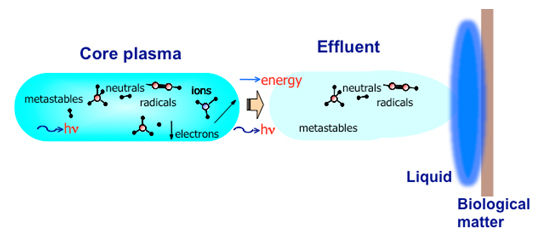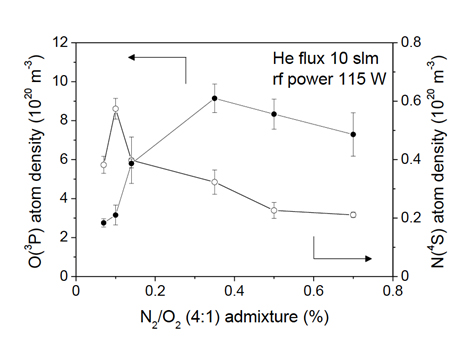Cold atmospheric pressure plasmas are emerging as precious tools for new applications with potential to revolutionise science, technology and health care. In order to control and tailor the presence of the highly reactive atomic species within the plasma, direct quantitative absolute measurements of reactive atoms density have been carried out at DESIRS beamline (FTS branch) by scientists from York University in collaboration with Ecole Polytechnique and SOLEIL teams.
These non-equilibrium plasmas are efficient sources of highly reactive neutral particles (e.g. atomic oxygen, atomic nitrogen, hydroxyl radical, superoxide, singlet oxygen, nitrogen oxides), charged particles, UV-radiation and electro-magnetic fields – see illustration in figure 1. Such components have already individually been implicated in therapeutics, but plasmas have the advantage over current technologies to produce these species simultaneously and to exploit synergies and superior mechanisms.
Recently, cold non-equilibrium plasmas could be operated stably at atmospheric pressure and room temperature opening new pathways in medicine and pharmacology e.g. cancer therapy, wound healing, antimicrobials, regenerative medicine, surgical tools and drug alternatives. Evidence to date suggests that highly reactive atomic species as key mediators in triggering the complex bio-chemical processes. Therefore, the ability to control and tailor the presence of these species within the plasma is a high priority. To this end, direct quantitative absolute measurements of reactive atoms density are essential.

Figure 1: Illustration of reactive species generation and energy transport mechanisms in cold non-equilibrium atmospheric pressure plasmas.
Experiments on the FTS branch of DESIRS
Quantitative measurements of highly reactive atomic oxygen and nitrogen atoms are extremely challenging, in particular in strongly collisional environments at atmospheric pressure. By using the unique high-resolution Fourier-transform spectrometer of the DESIRS VUV beamline, scientists of York University (UK), in collaboration with Ecole Polytechnique and SOLEIL teams, could carry out the first ever performed direct absorption measurements of absolute atomic oxygen and nitrogen densities in a cold atmospheric pressure plasma with complex air-like admixtures – see figure 2.

Figure 2 : Measured absolute densities of atomic oxygen and nitrogen in a radio-frequency driven cold atmospheric pressure plasma operated in helium with varying percentages of an air-like admixture.
Next steps
Potential future therapeutics will depend on tailoring the plasma properties and understanding the biological interaction mechanisms. Tailoring the plasma properties and associated chemical compositions e.g. through varying plasma power input and feed gas compositions, will require more detailed experimental studies and comparisons with model predictions.
The first measurements presented above and discussed in the corresponding publication have already built a solid basis for a new research endeavour in this direction.
